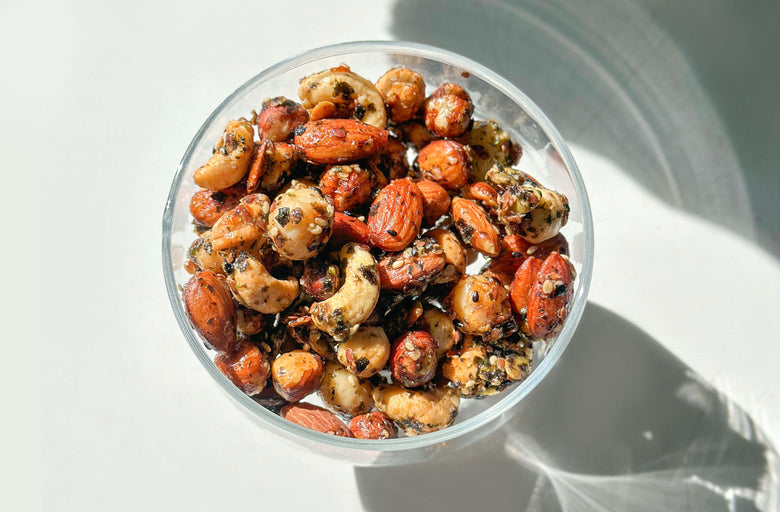One of our most commonly asked questions is "How many calories are in your meals?” At Sakara Life, we don’t count calories. Ever. We believe that focusing on calories is misleading. On a metaphysical level, it ties us to a number which takes the power away from trusting our own body’s intuition. It also adds undue stress—which can physically manifest, further discomforting and disconnecting us from our brightest, embodied selves. Dr. Mark Hyman who helms the Cleveland Clinic Center for Functional Medicine (and is the physician to former president Bill Clinton) is a friend and personal advisor to Sakara. We were blown away by his detailed overview of how our human biology rejects the concept of calories, and why focusing on getting enough (vitamins, minerals, phytonutrients, fiber, and colors) is the path to feeling and looking your best. We just had to share it with you.
Take it away Dr. Hyman.
"The vast majority of conventional nutritionists and doctors have it mostly wrong when it comes to weight loss. Let’s face it: If their advice were good and doable, we would all be thin and healthy by now. But as a general rule, it’s not. And the mainstream media messages often confuse things even more. It is based on many “food lies”.
And the biggest lie of them all is this: All calories are created equal.
Is this true? Not really. Let’s explore why.
Take a class of sixth graders. Show them a picture of 1,000 calories of broccoli and 1,000 calories of soda. Ask them if they have the same effect on our bodies. Their unanimous response will be “NO!” We all intuitively know that equal caloric amounts of soda and broccoli can’t be the same nutritionally. But as Mark Twain said, “The problem with common sense is that it is not too common.”
I guess that is why the medical profession, nutritionists, our government, the food industry, and the media are all still actively promoting the outdated, scientifically disproven idea that all calories are created equal. Yes, that well-worn notion—that as long as you burn more calories than you consume, you will lose weight—is simply dead wrong.
The first law of thermodynamics states that the energy of an isolated system is constant. In other words, in a laboratory, or “isolated system,” 1,000 calories of broccoli and 1,000 calories of soda are, in fact, the same. I’m not saying the law was wrong about that. It’s true that when burned in a laboratory setting, 1,000 calories of broccoli and 1,000 calories of soda would indeed release the same amount of energy.
But sorry, your law of thermodynamics doesn’t apply in living, breathing, digesting systems. When you eat food, the “isolated system” part of the equation goes out the window. The food interacts with your biology, a complex adaptive system that instantly transforms every bite.
To illustrate how this works, let’s follow 750 calories of soda and 750 calories of broccoli once they enter your body. First, soda: 750 calories is the amount in a Double Gulp from 7-Eleven, which is 100 percent sugar and contains 186 grams, or 46 teaspoons, of sugar. Many people actually do consume this amount of soda. They are considered the “heavy users.”
Your gut quickly absorbs the fiber-free sugars in the soda, fructose, and glucose. The glucose spikes your blood sugar, starting a domino effect of high insulin and a cascade of hormonal responses that kicks bad biochemistry into gear. The high insulin increases storage of belly fat, increases inflammation, raises triglycerides and lowers HDL, raises blood pressure, lowers testosterone in men, and contributes to infertility in women.
Your appetite is increased because of insulin’s effect on your brain chemistry. The insulin blocks your appetite-control hormone leptin. You become more leptin resistant, so the brain never gets the “I’m full” signal. Instead, it thinks you are starving. Your pleasure-based reward center is triggered, driving you to consume more sugar and fueling your addiction.
The fructose makes things worse. It goes right to your liver, where it starts manufacturing fat, which triggers more insulin resistance and causes chronically elevated blood insulin levels, driving your body to store everything you eat as dangerous belly fat. You also get a fatty liver, which generates more inflammation. Chronic inflammation causes more weight gain and diabesity. Anything that causes inflammation will worsen insulin resistance. Another problem with fructose is that it doesn’t send informational feedback to the brain, signaling that a load of calories just hit the body. Nor does it reduce ghrelin, the appetite hormone that is usually reduced when you eat real food.
Now you can see just how easily 750 calories of soda can create biochemical chaos. In addition, the soda contains no fiber, vitamins, minerals, or phytonutrients to help you process the calories you are consuming. These are “empty” calories devoid of any nutritional value. But they are “full” of trouble. Your body doesn’t register soda as food, so you eat more all day long. Plus, your taste buds get hijacked, so anything that is not super-sweet doesn’t taste very good to you.
Think I’m exaggerating? Cut out all sugar for a week, then have a cup of blueberries. Super-sweet. But eat those same blueberries after bingeing on soda and they will taste like bland and boring.
Now let’s look at the 750 calories of broccoli. As with the soda, these calories are made up primarily (although not entirely) of carbohydrates—but let’s clarify just what that means, because the varying characteristics of carbs will factor significantly into the contrast I’m about to illustrate.
Carbohydrates are plant-based compounds comprised of carbon, hydrogen, and oxygen. They come in many varieties, but they are all technically sugars or starches, which convert to sugar in the body. The important difference is in how they affect your blood sugar. High-fiber, low-sugar carbohydrates such as broccoli are slowly digested and don’t lead to blood sugar and insulin spikes, while table sugar and bread are quickly digested carbs that spike your blood sugar. Therein lies the difference. Slow carbs like broccoli heal rather than harm.
Those 750 calories of broccoli make up 21 cups and contain 67 grams of fiber (the average American consumes 10 to 15 grams of fiber a day). Broccoli is 23 percent protein, 9 percent fat, and 68 percent carbohydrate, or 510 calories from carbs. The “sugar” in 21 cups of broccoli is the equivalent of only 1.5 teaspoons; the rest of the carbohydrates are the low-glycemic type found in all non-starchy vegetables, which are very slowly absorbed.
Still, are the 750 calories in broccoli really the same as the 750 calories in soda? Kindergarten class response: “No way!” So why do we all think that’s true, and why has every major governmental and independent organization bought into this nonsense?
Let’s take a closer look at just how different these two sets of calories really are.
First, you wouldn’t be able to eat twenty-one cups of broccoli, because it wouldn’t fit in your stomach. But assuming you could, what would happen? They contain so much fiber that very few of the calories would actually get absorbed. Those that did would get absorbed very slowly. There’d be no blood sugar or insulin spike, no fatty liver, no hormonal chaos. Your stomach would distend (which it doesn’t with soda; bloat from carbonation doesn’t count!), sending signals to your brain that you were full. There would be no triggering of the addiction reward center in the brain. You’d also get many extra benefits that optimize metabolism, lower cholesterol, reduce inflammation, and boost detoxification. The phytonutrients in broccoli (glucosinolates) boost your liver’s ability to detoxify environmental chemicals, and the flavonoid kaempferol is a powerful anti-inflammatory. Broccoli also contains high levels of vitamin C and folate, which protect against cancer and heart disease. The glucosinolates and sulphorophanes in broccoli change the expression of your genes to help balance your sex hormones, reducing breast and other cancers.
What I’m trying to illustrate here (and this is probably the single most important idea in this book) is that all calories are NOT created equal. The same number of calories from different types of food can have very different biological effects.
If you still think a calorie is just a calorie, maybe this study will convince you otherwise. In a study of 154 countries that looked at the correlation of calories, sugar, and diabetes, scientists found that adding 150 calories a day to the diet barely raised the risk of diabetes in the population, but if those 150 calories came from soda, the risk of diabetes went up by 700 percent.
Some calories are addictive, others healing, some fattening, some metabolism-boosting. That’s because food doesn’t just contain calories, it contains information. Every bite of food you eat broadcasts a set of coded instructions to your body—instructions that can create either health or disease.
So what will it be, a Double Gulp or a big bunch of broccoli?"






